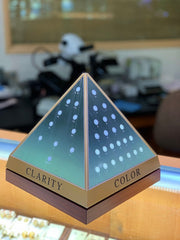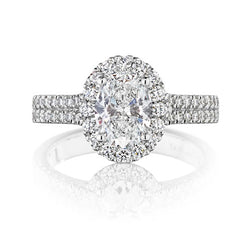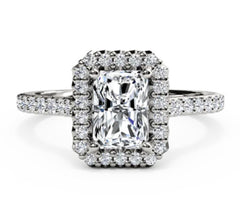So, you're shopping for a diamond, and you're wondering where you should begin? Whether you're in the market for the perfect engagement ring, sparkling diamond earrings, or a stunning tennis bracelet, diamond shopping can stir up a mix of emotions. It's undoubtedly an exciting time but can often be accompanied by a bit of confusion and anxiety. And that's where we come in.
At Fink's Jewelers, we want you to be able to enjoy this experience and enjoy the process knowing you're in the hands of experts you can trust. That's why we are all about educating you on diamond shopping - what to look for and how to shop for your diamonds.
How are Fink's Diamonds Graded?
You will often hear references to the 4Cs (also known as the "four Cs"); the GIA International Diamond Grading System which evaluates diamonds on their color, clarity, cut, and carat weight. These are recognized standards that will help you determine the quality of the diamond you are considering purchasing. At Fink's Jewelers, we've added another C. In fact, one of the many things that set us apart from other jewelers is our fifth C; Clif. Clif is our secret weapon. Through detailed hands-on review, Clif ensures only the very best diamonds pass his rigorous inspection and become a Fink's Diamond.
First, Meet Clif
For over two decades, Clif has been hand-selecting every single Fink's diamond we offer. Most jewelers buy in "parcels," or groups of diamonds all within a specified grading range. But not at Fink's. Clif individually inspects each diamond in its entirety to ensure it offers optimal cut, light performance, and brilliance that meet his high standards. Clif even inspects each diamond for durability – an extra step most retailers typically don't take. He is extremely meticulous, rejecting 99% of the diamonds he inspects each year. You see, every diamond is much more than its grading report displays. No two diamonds are ever alike. Even those that may receive the same grading often display major differences. When selecting which diamonds become a Fink's diamond, Clif asks himself this question every time: "Would I put it on my wife's hand?" If the answer is no, it gets rejected.
Throughout this article, we'll explain the origin of the 4Cs and let you know how Clif's expertise allows us to guarantee you the absolute best value for your diamond ring at Fink's Jewelers.
Creating a Standard

We understand better than anyone how easy it is to get swept away in the beauty and excitement of diamond shopping! We want to help make this an experience to remember by arming you with a bit of information on what you should look for and why it's essential when you're purchasing your diamond.
Each diamond is exquisitely unique, but it wasn't until the 1940s that we began to see a standard created and used to evaluate the quality of diamonds. To create a trustworthy and ethical set of standards, one man went to work on developing a system that would bring consistency to diamond buying. Created initially as a mnemonic device for his students, the 4Cs were taught by Robert M. Shipley in a brilliant effort to educate and advocate for standards and ethics in the diamond business. Not only did Shipley's 4Cs become widely used and appreciated in America, but were later adopted internationally as well.
The 4Cs of a Diamond
The 4Cs provide consistency and reliability throughout the diamond industry. It has revolutionized the buying and selling of diamonds. By providing these strict standards for color, cut, clarity, and carat weight, you can trust that you are receiving accurate and objective information about the diamond you are viewing. This worldwide adopted grading system also ensures you peace of mind that your diamond is evaluated as the same quality across the board.
The Diamond Color
Prior to Shipley's 4Cs, diamond customers were often left at the mercy of the merchant. The color of a diamond was loosely categorized as an A, AA, or AAA, without any rigid guidelines for assigning a diamond to one of these categories.
In the 1930s, GIA began working on a color-grading system that could be more objective. Their efforts focused on diamonds ranging from colorless (rated D) to pale yellow. In 1953, the GIA D-to-Z Color Scale was unveiled, along with precise methods to be followed in order to rate the color of a diamond consistently.
While diamonds can be found in a range of colors, the smallest difference between two stones could make a world of difference in their quality and price. In fact, to the naked eye, the slight variation in color between the diamond grade above and below the stone you're admiring may even go unnoticed, but the grading and price will certainly set them apart.
Fink's Jewelers only offers stones in our Superior Quality® color range, D-to-K.
The Diamond Clarity

Clarity was another area full of misleading and inconsistent descriptions. Terms such as perfect, near perfect, flaws, and imperfections were much too vague and subjective. With a need for structure and ethical guidelines, the GIA Clarity Scale was created.
Keep in mind that virtually all stones will have inclusions; tiny imperfections inside the diamond. They may even have subtle blemishes; imperfections found on the surface of the stone. These imperfections are a result of the intense pressure and heat a stone undergoes when formed. Grading a diamond for clarity is determined by various factors including the size, number, and location of these imperfections that are seen when under 10x magnification. Quite a difference from the few terms originally used to describe clarity.
The Clarity Scale created categories and grades for diamonds to be placed into, according to the presence of their imperfections. While a few jewelers were already using something similar to a clarity system, there was still a great need for accuracy and higher standards to be put into place. The Clarity Scale created precision for assigning each diamond. The scale includes six different categories:
- Flawless
- Internally flawless
- Very very slightly included
- Very slightly included
- Slightly included
- Included
At Fink's, we only offer diamonds that have no inclusions that are obviously visible to the naked eye. This ensures every Fink's Diamond meets our Superior Quality® standards.

Great efforts were made in order to ensure that clarity grading was precise, and the customer was able to see a diamond's imperfections. At Fink's, Clif inspects each stone under a gemological microscope to further inspect the diamond's clarity. When doing this, he's looking for several specific imperfections. A large feather, or fracture, in the diamond will typically appear as a slightly white area and can be seen by the naked eye. Dark inclusions are carbon spots that failed to crystallize properly and have the appearance of tiny black spots. Clif will also check for reflectors, which are mirrored images of an inclusion. Large indented naturals, which are typically on the girdle (edge) of the diamond are avoided because they can affect the stones durability. If a feather is at the surface of a stone, a cavity or small opening can be created. And lastly, Clif looks for knots found on the stone's surface, which could also affect the stone's durability over time. All of these imperfections make a big difference when sourcing a "good" SI2 vs. a "bad" SI2.
Let's take a look at the two diamond examples below. Although both of these stones are graded by the GIA and given H color, and SI2 clarity, there are noticeable differences between them. When the stones are viewed underneath high-powered magnification, the differences are undeniable. We can see many inclusions and a much cloudier appearance in the image to the right. The image of the stone on the left appears free of noticeable inclusions and has a bright sparkle. Only the diamond on the left will meet Clif's strict criteria to be a Fink's Diamond, even though both carry the same GIA grading report. We hope this helps you understand the importance of buying your diamond from an established and reputable jeweler.

Clif goes beyond the grading report with each and every diamond and only selects the best value within our Superior Quality Range. While shopping for your diamond, it's important to view the grading report, but even more important to view the stone under a gemological microscope for yourself. There, you'll see the diamond for what it truly is.
The Diamond Cut
Over many decades, the diamond cut rating system has gone through various revisions and modifications. In order to create specific standards for evaluating a diamond's cut, mathematician Marcel Tolkowsky was first consulted. A respected Belgian Diamond Cutter, he provided his expertise to help develop proportions that would be considered ideal in a brilliant round-cut diamond. By 2006, there had been ample research done using state-of-the-art technology. Through the use of computer modeling and observation, an updated and more accurate grading system was developed. This system includes five grades:
- Excellent
- Very good
- Good
- Fair
- Poor
The cut of a diamond is crucial since it ultimately determines how the diamond will "perform." The cut will determine the light's reflection, the brilliance of the stone's sparkle, and even the visual appearance of the stone's size. When a diamond performs well, it is largely due to three factors:
- Polish
- Symmetry
- Proportions
At Fink's, we believe the way a diamond is cut can truly make all the difference. Perfecting the cut of a diamond is an art form and an incredible skill that can take many years to perfect. When a diamond's cut is evaluated, it is being inspected for the way it interacts with light. You'll want to look for a symmetrical diamond with a radiant sparkle when it reflects light. How does it perform? A well-cut diamond will be able to capture and reflect light brilliantly. If a stone is poorly cut, it can tend to have a dull, lifeless look to it.
Clif inspects every Fink's diamond closely, searching for perfectly cut proportions and evaluating each stone for symmetry to meet our Superior Cut® standards. If a diamond's cut is too shallow or even too deep, the loss of light will affect its brilliance as well as value. Clif knows from his years of experience how the perfect Fink's diamond should play with the light and turns away any that don't impress him. Is there any question as to why our diamonds sparkle brighter than any others?
The Diamond Carat Weight
The carat refers to the weight of a diamond but is so often mistaken for the size. It's important to remember that a stone's cut can play a large role in its appearance in size and should not be mistaken for its carat weight.
A metric carat weight can be defined as 200 milligrams. Each carat is then subdivided into 100 points to allow a Jeweler's measurements to be extremely precise; down to the hundredth decimal to be exact. While we know the value of a diamond certainly increases with its carat weight, don't forget the previous 3Cs still play a large role in its value as well.
Armed with Knowledge
Now that you're full of diamond knowledge, you're ready to begin your search for the perfect diamond. We're always here to answer any of your diamond questions and help with your jewelry buying needs. If in doubt, just remember our fifth C and ask yourself "would Clif put this diamond on his wife's hand?" Ready to start the search for your diamond? We invite you to take a look at our stunning selection or come in and see us at one of our many locations today!









